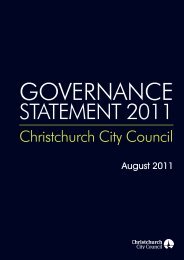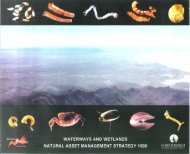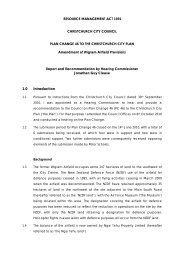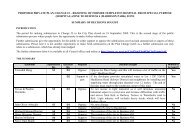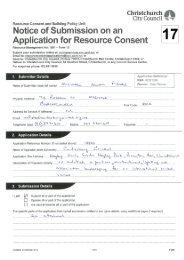Annual Report 2010 - Christchurch City Council
Annual Report 2010 - Christchurch City Council
Annual Report 2010 - Christchurch City Council
Create successful ePaper yourself
Turn your PDF publications into a flip-book with our unique Google optimized e-Paper software.
p144.<br />
<strong>Annual</strong> <strong>Report</strong><br />
<strong>Christchurch</strong> Otautahi<br />
<strong>2010</strong><br />
Financial statements<br />
Statement of<br />
accounting policies<br />
(continued)<br />
Notes to financial statements<br />
1. Statement of accounting policies (continued)<br />
Principles of consolidation<br />
(i) Subsidiaries<br />
Subsidiaries include special purpose entities and are those<br />
over which the <strong>Council</strong> has the power to govern financial and<br />
operating policies, generally accompanying a shareholding<br />
of at least half of the voting rights. Potential exercisable or<br />
convertible voting rights are considered when assessing<br />
whether the <strong>Council</strong> controls another entity.<br />
Subsidiaries are fully consolidated from the date on which<br />
control is transferred to the <strong>Council</strong> and de-consolidated from<br />
the date control ceases.<br />
The purchase method of accounting is used to account for the<br />
acquisition of subsidiaries.<br />
Intercompany transactions, balances and unrealised gains<br />
on transactions are eliminated. Unrealised losses are also<br />
eliminated, unless the transaction provides evidence of the<br />
impairment of the asset transferred. Accounting policies of<br />
subsidiaries have been changed where necessary to ensure<br />
consistency with the policies adopted by the <strong>Council</strong>.<br />
Minority interests in the results and equity of subsidiaries<br />
are shown separately in the consolidated statement of<br />
comprehensive income and balance sheet.<br />
(ii) Associates<br />
Associates are entities over which the <strong>Council</strong> has significant<br />
influence but not control, generally accompanying a<br />
shareholding of between 20% and 50% of the voting rights.<br />
Investments in associates are accounted for in the parent’s<br />
financial statements using the cost method and in the<br />
consolidated financial statements using the equity method,<br />
after initially being recognised at cost. The <strong>Council</strong>’s<br />
investment in associates includes goodwill (net of any<br />
accumulated impairment loss) identified on acquisition.<br />
The <strong>Council</strong>’s share of its associates’ post acquisition profits or<br />
losses is recognised in the profit and loss, and its share of post<br />
acquisition movements in reserves is recognised in reserves.<br />
The cumulative post acquisition movements are adjusted<br />
against the carrying amount of the investment. Dividends<br />
receivable from associates are recognised in the parent’s profit<br />
and loss, while in the consolidated financial statements they<br />
reduce the carrying amount of the investment.<br />
When the <strong>Council</strong>’s share of losses in an associate equals<br />
or exceeds its interest in the associate, including any other<br />
unsecured receivables, the <strong>Council</strong> does not recognise further<br />
losses, unless it has incurred obligations or made payments on<br />
behalf of the associate.<br />
Unrealised gains on transactions between the <strong>Council</strong> and<br />
its associates are eliminated to the extent of the <strong>Council</strong>’s<br />
interest in the associates. Unrealised losses are also eliminated<br />
unless the transaction provides evidence of an impairment of<br />
the asset transferred. Accounting policies of associates have<br />
been changed where necessary to ensure consistency with the<br />
policies adopted by the <strong>Council</strong>.<br />
(iii) Joint Ventures<br />
Joint ventures are those over whose activities the group has<br />
joint control, established by contractual agreement. The<br />
group’s share of the assets, liabilities, revenues and expenses<br />
of any joint venture is incorporated into the group’s financial<br />
statements on a line by line basis using the proportionate<br />
method.<br />
Foreign currency transactions<br />
Transactions in foreign currencies are translated at the foreign<br />
exchange rate ruling on the day of the transaction.<br />
Foreign currency monetary assets and liabilities at the balance date<br />
are translated to NZ dollars at the rate ruling at that date. Foreign<br />
exchange differences arising on translation are recognised in the<br />
profit and loss, except when deferred in equity as qualifying cash<br />
flow hedges and qualifying net investment hedges.<br />
Non-monetary assets and liabilities that are measured in terms<br />
of historical cost in a foreign currency are translated using the<br />
exchange rate at the date of the transaction.<br />
Non-monetary assets and liabilities denominated in foreign<br />
currencies that are stated at fair value are translated to NZ dollars at<br />
rates ruling at the dates the fair value was determined.<br />
Translation differences on equities held at fair value through profit<br />
or loss are reported as part of the fair value gain or loss. Translation<br />
differences on equities classified as available-for-sale financial<br />
assets are included in the fair value reserve in equity.





